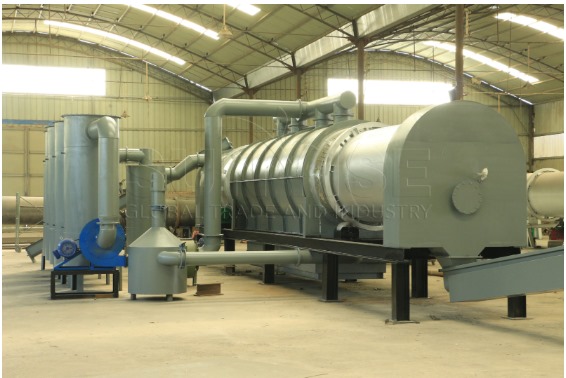Enhancing Charcoal Production Efficiency with Large-Scale Continuous Furnaces
Updated: 21 Oct 2025
22
In today’s world, where sustainability and energy efficiency are key industrial goals, the charcoal manufacturing industry has witnessed significant advancements. One of the most impactful innovations is the introduction of large-scale continuous furnaces—a game-changer for any charcoal production plant aiming to increase output, reduce costs, and minimize environmental impact. These high-performance systems have revolutionized how biomass materials are transformed into high-quality charcoal on an industrial scale.
Understanding the Basics of Charcoal Production
Charcoal production traditionally relied on small, batch-type kilns that required manual feeding, long processing times, and significant fuel consumption. The process often involved burning wood or other biomass in low-oxygen environments to produce carbon-rich material. While effective, such methods had low efficiency and produced inconsistent results.
Modern charcoal production plants, however, are designed to automate and streamline this process. By incorporating mechanical feeding systems, temperature control, and advanced furnace technologies, these plants can achieve continuous, large-scale production with minimal human intervention.
What Are Large-Scale Continuous Furnaces?
Large-scale continuous furnaces are advanced carbonization systems designed to process biomass materials like wood chips, coconut shells, sawdust, rice husks, and agricultural waste continuously. Instead of operating in batches, these furnaces maintain a constant flow of raw material, allowing simultaneous feeding, carbonization, and discharge of finished charcoal.
Unlike traditional methods that require cooling and restarting between each cycle, continuous furnaces use rotary or multi-layer designs that sustain uniform temperatures and airflow. The outcome is a stable production process capable of delivering higher yields, better energy efficiency, and superior product quality.
Working Principle of Continuous Furnaces
The operation of a large-scale continuous furnace follows a systematic process:
- Feeding and Pre-treatment:
The raw materials are first crushed and dried to achieve the ideal moisture level—typically below 15%. This ensures consistent carbonization and prevents incomplete burning. - Carbonization Process:
Inside the furnace, the biomass undergoes thermal decomposition in a low-oxygen environment. The temperature is carefully controlled, usually between 300°C and 600°C. As the temperature rises, volatile gases are released and partially reused as fuel to maintain the system’s internal heat, enhancing energy efficiency. - Cooling and Discharge:
The carbonized material moves through a cooling zone before being automatically discharged as finished charcoal. The cooling system ensures safe handling and maintains product integrity. - Emission Control:
High-quality systems, like those from Yushunxin Charpro, include smoke purification and gas recycling units that minimize emissions and reduce environmental pollution.
Advantages of Large-Scale Continuous Furnaces
Integrating large-scale continuous furnaces into a charcoal production plant offers multiple operational and environmental advantages:
1. High Production Capacity
Continuous operation enables the system to handle several tons of biomass per day. Production capacities can range from 500 kg/h to several thousand kg/h, depending on the model and material type.
2. Improved Energy Efficiency
The furnaces utilize combustible gases generated during carbonization to fuel the process itself. This internal recycling mechanism cuts down external fuel costs and enhances overall thermal efficiency.
3. Stable Quality Output
Automated temperature and airflow controls ensure every batch of charcoal meets consistent standards in density, carbon content, and burn time.
4. Reduced Labor and Downtime
Automation reduces the need for manual monitoring, feeding, and unloading. Continuous systems eliminate the downtime associated with batch cooling and restarting.
5. Environmentally Friendly Operation
Equipped with gas purification and recycling units, these furnaces release minimal smoke or toxic gases. They align well with global environmental standards for green manufacturing.
6. Long Service Life
Made from high-quality stainless steel and equipped with heat-resistant linings, large-scale furnaces are built for durability and continuous industrial operation.
Integrating Continuous Furnaces into a Charcoal Production Plant
A complete charcoal production plant typically includes several integrated systems that work alongside the carbonization furnace.
1. Crushing and Drying Units
These machines prepare the raw materials by reducing size and moisture. Consistent material input ensures smoother furnace performance.
2. Continuous Carbonization Furnace
This is the heart of the operation, converting biomass into charcoal efficiently and continuously.
3. Cooling and Conveying Systems
Automatic conveyors transport the finished charcoal to cooling units and storage areas.
4. Dust and Smoke Purification Equipment
Environmental protection units remove particulates and harmful gases, ensuring clean emissions.
5. Briquette or Packaging Machines
In some setups, charcoal is compressed into uniform shapes—like briquettes—for commercial or industrial sale.
By combining these components, a charcoal plant can achieve seamless production with minimal human input while maximizing yield and quality.
Applications and Market Demand
The demand for high-quality charcoal continues to rise globally due to its diverse applications:
- BBQ Charcoal: Clean-burning, odorless charcoal preferred by food industries.
- Industrial Fuel: Used in metallurgy, foundries, and power generation.
- Activated Carbon Production: A key raw material for water and air purification industries.
- Agricultural Soil Amendment: Biochar improves soil health and carbon retention.
For producers, investing in large-scale continuous furnaces allows them to serve these markets with consistency and efficiency, positioning their charcoal production plant as a sustainable energy solution provider.
Factors to Consider When Choosing a Continuous Furnace
Before investing in a large-scale furnace, plant owners should evaluate:
- Raw Material Type: Different biomass materials have varying carbonization behaviors.
- Moisture Content: Pre-drying may be required for materials with high humidity.
- Energy Supply: Ensure stable power or gas availability to maintain furnace operation.
- Environmental Compliance: Select systems equipped with emission control units.
- Manufacturer Reliability: Choose a supplier with proven experience, warranty coverage, and after-sales support—such as Yushunxin Charpro.
Building a Sustainable Future with Modern Charcoal Plants
The transition from traditional kilns to automated charcoal production plants powered by large-scale continuous furnaces marks a major step forward for the biomass industry. These innovations not only increase productivity and profitability but also align with environmental sustainability goals.
By leveraging cutting-edge carbonization technologies, manufacturers can efficiently convert waste biomass into valuable, eco-friendly charcoal products—reducing reliance on fossil fuels and contributing to a cleaner, greener planet.
Conclusion
Modern large-scale continuous furnaces have completely transformed the landscape of charcoal manufacturing. Their ability to handle massive volumes, maintain consistent quality, and operate with minimal emissions makes them indispensable for any forward-thinking charcoal production plant. As global demand for renewable energy and sustainable materials continues to grow, investing in advanced carbonization technology ensures long-term profitability, efficiency, and environmental responsibility.
For industries or entrepreneurs seeking reliable, high-performance charcoal equipment, exploring solutions like the Continuous Carbonization Furnace and Charcoal Production Line from Yushunxin Charpro is an ideal place to start.


Please Write Your Comments